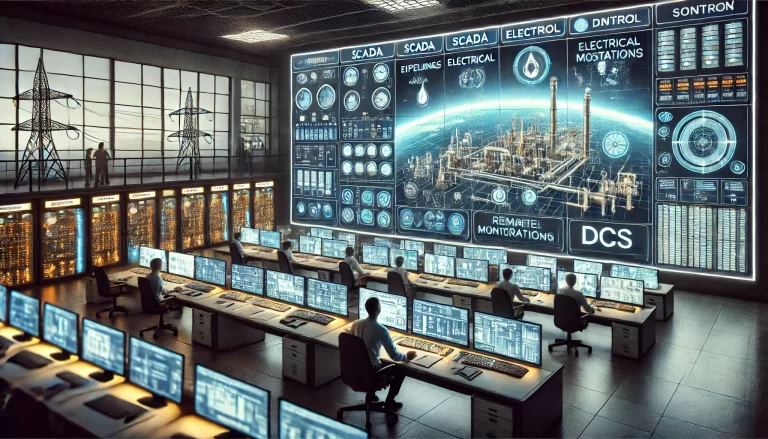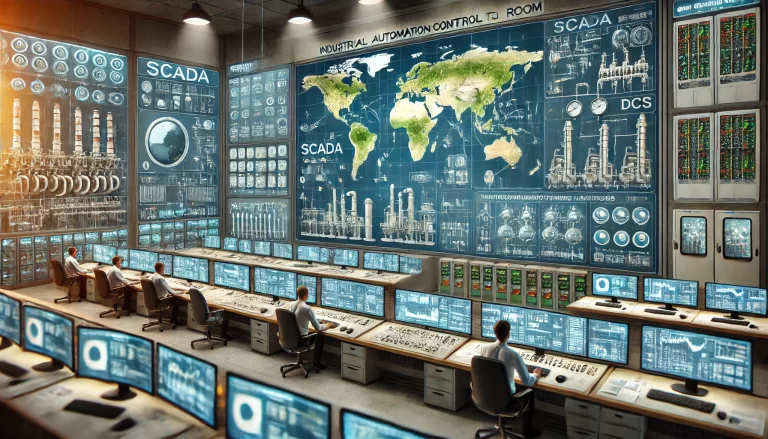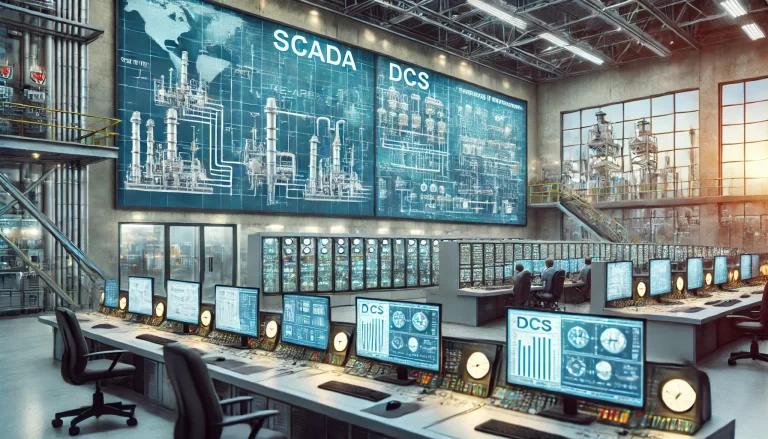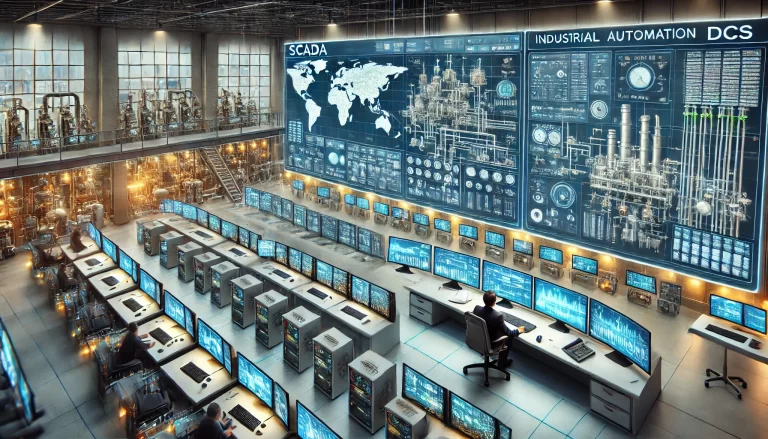In industrial automation, SCADA (Supervisory Control and Data Acquisition) and DCS (Distributed Control System) are two commonly used systems that serve different purposes. Both play essential roles in the control and monitoring of industrial processes, but they differ significantly in terms of structure, application, and functionality. Understanding these differences is crucial when deciding which system is more appropriate for a particular industrial process.
1. System Architecture
The fundamental difference between SCADA and DCS lies in their system architecture.
SCADA: SCADA is designed as a centralized system that monitors and controls a large number of distributed assets. It is primarily used for remote monitoring over large geographical areas. SCADA systems collect data from sensors and field devices located at different sites and transmit this data to a central computer, where operators can monitor and control the systems. This is often done through Human-Machine Interfaces (HMIs) that provide visualization tools for operators. The SCADA system itself generally does not directly control the processes but sends commands to local controllers or Programmable Logic Controllers (PLCs), which carry out the control functions.
DCS: DCS, on the other hand, is a decentralized control system used to automate complex industrial processes within a single facility, such as a factory or plant. In a DCS, the control functions are distributed among multiple local controllers, each responsible for specific aspects of the industrial process. The DCS is designed to handle highly detailed and sophisticated control over processes, such as temperature, pressure, flow, and chemical reactions. The focus of a DCS is to manage a continuous process, ensuring real-time control and automation within a defined production area.

2. Control Range and Application
SCADA and DCS systems serve different types of industries and applications based on the scope of their control range.
SCADA: SCADA systems are ideal for monitoring and controlling processes that are geographically dispersed. For example, they are widely used in utilities like electrical grids, water distribution systems, and oil and gas pipelines. SCADA systems are optimized for collecting and displaying data from remote locations where direct control may not be feasible. Operators can use this data to make decisions or take actions based on alerts or anomalies. The central feature of SCADA is its ability to provide a bird’s-eye view of wide-area processes.
DCS: A DCS is more suited to a single facility, such as a manufacturing plant, oil refinery, or chemical processing plant. The focus of a DCS is on real-time process control within a localized environment, ensuring that production is maintained within safe and efficient operating parameters. Each controller in a DCS is tasked with managing a specific part of the process, and these controllers work together to ensure seamless and coordinated operation. This makes DCS ideal for highly integrated and tightly controlled environments where small variations in parameters like temperature or pressure can lead to significant outcomes.

3. Real-Time Control
One of the most important distinctions between SCADA and DCS is their approach to real-time control.
SCADA: SCADA systems are not primarily designed for real-time control, although they can provide real-time data monitoring. The focus is more on data acquisition and supervisory control, with real-time responses being limited to specific events or triggers. SCADA systems often have slower response times compared to DCS, as the control actions are either implemented by remote devices or by human operators based on the collected data. This makes SCADA suitable for applications that do not require rapid response to changes, such as environmental monitoring or energy distribution.
DCS: DCS systems are optimized for real-time process control, where split-second decisions and actions are necessary to maintain process integrity. In a DCS, each local controller is responsible for directly managing its part of the process, and all the controllers are interconnected to provide coordinated control. This ensures high-speed responses to process changes, making DCS essential in environments where any delay in control can lead to unsafe conditions or production inefficiencies, such as in chemical processing or power generation.
4. Redundancy and Reliability
Both SCADA and DCS systems must ensure high reliability, but the ways they achieve this differ.
SCADA: SCADA systems tend to rely on the reliability of communication networks and the field devices they monitor. They are often connected via various communication protocols (e.g., Ethernet, fiber optics, or wireless). While redundancy may be built into the communication systems, the overall control and decision-making processes may depend on fewer central points. SCADA systems prioritize data integrity and availability, but they are typically less focused on ensuring process safety compared to DCS.
DCS: DCS systems typically offer higher levels of redundancy because they are designed for mission-critical process control in industries like refining, petrochemical, and power generation. A typical DCS will have redundant controllers, networks, and power supplies to ensure that any failure in one component does not bring down the entire system. This level of redundancy is necessary because the processes controlled by a DCS are often too critical to tolerate downtime. For example, in a power plant, any failure in the DCS could lead to an unscheduled shutdown, which can be costly or dangerous.

5. Scalability and Flexibility
SCADA: SCADA systems are highly scalable and flexible, as they are designed to monitor processes spread over large distances. New devices and sensors can be added easily to a SCADA network, making it ideal for industries that need to expand or modify their systems frequently, such as transportation or water utilities. SCADA systems can also integrate with other technologies like Geographic Information Systems (GIS) to provide spatial analysis and decision-making tools.
DCS: DCS systems, while scalable to a certain extent, are typically more rigid because they are designed to control a specific process within a defined facility. Expanding or modifying a DCS system usually requires more effort, as changes must be integrated into the complex process control algorithms that govern the production environment. However, the inherent design of DCS provides high levels of precision and control, which may not be required in SCADA applications.
6. Application Examples
SCADA: Examples of SCADA applications include water and wastewater treatment plants, electrical power grids, oil and gas pipelines, and transportation networks like rail systems. These industries require centralized monitoring and control of widely dispersed assets and can benefit from SCADA’s ability to visualize data and trigger alarms for abnormal conditions.
DCS: DCS is commonly used in process industries like chemical manufacturing, oil refineries, power generation, and food processing. These environments require real-time control, safety interlocks, and fine-tuned process optimization. DCS systems are essential for managing continuous processes where failure to control parameters like temperature or pressure could result in hazardous conditions or financial losses.

Conclusion
In summary, SCADA and DCS are both essential systems in industrial automation, but they cater to different needs. SCADA is ideal for monitoring and supervisory control over geographically distributed assets, with a focus on data collection and visualization. DCS, on the other hand, is designed for real-time, precise control of complex processes within a single facility, ensuring high levels of safety, reliability, and automation.
Understanding these differences helps industries choose the right system based on their specific operational needs, whether they require the wide-area monitoring capabilities of SCADA or the fine-grained process control of DCS.
